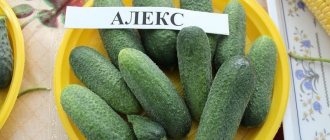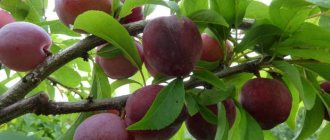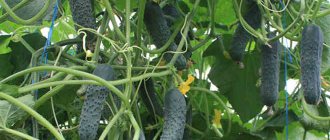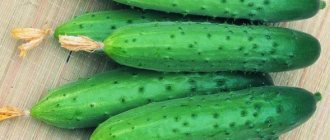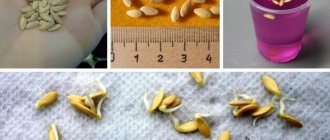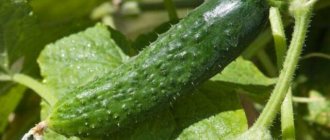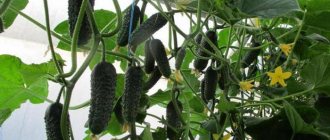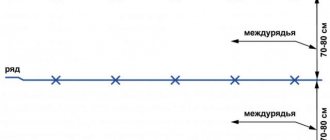Cucumber Sestritsa Alyonushka F1 is a hybrid variety that belongs to the latest breeding achievements of the originator Aelita Agro. Shows high complex disease resistance and productivity in the line of bee-pollinated cucumbers.
| Landing location | Ripening time | Mode of application | Fruit length | Group | Fruit smoothness | Pollination method |
| Universal | Early ripening (35-45 days) | Universal | Short (gherkins) - less than 10 cm | Hybrid | Highly lumpy | Bee pollinated |
Description and characteristics of the variety
Cucumber Sister Alyonushka F1 requires insects for pollination. Cultivated in open soil and in protected beds. Main features:
- pollinated by bees;
- bushes are compact, with moderate branching;
- bunch fruiting;
- many female inflorescences;
- in one node - 2-3 fruits.
The first gherkins are harvested 50 days after germination.
Features of Zelentsy:
- gherkin type;
- length - up to 7.5 cm;
- weight - 70–85 g;
- diameter - up to 2.7 cm;
- dark green color;
- sparsely spaced tubercles;
- crispy pulp;
- spines - white;
- pubescence - average.
Zelentsy are delicious fresh or pickled. Used assorted and for pickling. They do not become bitter when outgrown. During heat treatment they do not lose elasticity and hardness.
Advantages and disadvantages
The Sestritsa Alyonushka variety may not be as famous as other popular cucumbers. But those who chose it for growing in their garden plots note many positive qualities.
Advantages:
- high yield rates;
- good taste, which is characteristic of bee-pollinated cucumbers;
- resistance to sudden temperature changes;
- stable fruit yield;
- long fruiting period;
- suitability for transportation;
- excellent presentation of cucumbers;
- resistance to major infections affecting the crop (in particular, the hybrid is not affected by powdery mildew);
- versatility of use.
Flaws:
- absence of parthenocarpy. The need to plant pollinators and attract bees;
- You cannot collect seeds for subsequent sowings. Hybrids labeled F1 do not retain parental characteristics in subsequent generations, so gardeners need to purchase new seeds every year.
It is believed that pollinated cucumbers are tastier than parthenocarpic cucumbers, although the statement is controversial. But the fact that the taste characteristics of this hybrid are excellent is confirmed by numerous reviews from summer residents.
Landing
When cultivating through seedlings, seed material is planted 30–32 days before the planned transplant. Bushes are grown in containers with a volume of 0.3–0.4 liters. Select a nutritious light soil mixture with peat, compost, and humus.
Seeds are sown in the beds when the ground warms up to 14 degrees:
- in temperate latitudes - the last days of May;
- in the north - from the second week of June;
- in the southern regions - from the third ten days of May.
Seating scheme - 30 by 70 cm.
Features of growing cucumber Sestritsa Alyonushka F1
The recommendations of the State Register indicate that it is advisable to grow the variety on open ground ridges. In greenhouses, the yield will be higher, but provided that the pollination procedure is ensured. Otherwise, even with abundant flowering, there will be no ovaries.
In the southern regions, it is possible to sow seeds directly into the ground; in other regions, seedlings are first grown. The choice of cultivation method depends on the capabilities of the gardener and the climate of the area.
Sowing seeds and growing seedlings
For sowing and growing cucumber seedlings, prepare containers and a nutrient mixture in advance. It is recommended to sow the seeds in separate pots and cups, as the crop does not tolerate picking.
A good option for planting is peat cassettes, tablets, pots. Many summer residents make cups from paper, which, when planting seedlings, are easy to cut and remove the plant without damaging the roots.
The time for sowing seeds is determined taking into account:
- climate of the area;
- weather;
- the place where the cucumbers will grow (greenhouses, open beds).
Soil mixtures are also prepared in advance by purchasing ready-made compounds in stores or mixing the necessary components yourself. When purchasing ready-made soil mixtures, turf soil, river sand, and wood ash are added to peat compositions. Pure peat compositions are not used for seedlings.
To prepare mixtures, mix the components yourself in a 2:2:1 ratio:
- turf or leaf soil;
- humus;
- calcined river sand of coarse fraction.
May be interesting Pepper “Bison Yellow”: early, universal purpose Excellent potato yields without hilling and weeding Characteristics of the “Amursky” grape variety
Soil acidity indicators are about pH 6.7.
Time for sowing seeds for seedlings:
- in the middle zone for heated greenhouses - from April 10 (with planting in greenhouses in early or mid-May);
- in the middle zone for open ground cucumbers - early May (transplanting seedlings into the ground - early June);
- in the regions of the North-West, Siberia, and the Urals, sowing seedlings - in early May, so that after about 24-26 days the plants are planted in the greenhouse;
- Cucumbers are planted in beds in these areas no earlier than June 10-15, with mandatory protection from possible frosts.
Cucumber seedlings require lighting and watering. Water moderately as the soil dries. Control soil moisture, preventing drying out and excessive moisture.
Feed 1-2 times, using complex formulations or ready-made fertilizers for seedlings (Fertika, Agricola). Approximately 8-12 days before planting, the seedlings are accustomed to new conditions by taking them out into the fresh air or onto the balcony. Hardening is necessary, since such plants tolerate transplantation better, do not get sick, and grow quickly.
Care
Loosen the soil with a hoe between the rows of cucumbers, carefully, trying not to damage the root system and stems. To increase the yield, you can lightly hill up the cucumber bushes. You need to loosen before flowering. It is recommended to do this after watering to prevent the formation of a soil crust and give the earth access to oxygen.
Watering Sister Alyonushka depends on the growth periods of cucumbers:
- At the beginning, you need to moisturize moderately and reduce its frequency and abundance during the formation of flowers.
- Later the frequency is increased.
- In hot and dry weather, it is important to water the soil under the cucumbers as the soil dries out.
Attention!
It is necessary to eliminate weeds - this will reduce the risk of infection by fungi and help prevent them from “sucking” nutrients from the soil.
The location of cultivation is of great importance. You can choose a hill or a flat area. There should always be enough sunlight. It will be better if you plant cucumbers in their former place:
- potatoes;
- Luke;
- beans;
- tomatoes.
Follow a planting pattern of 50x30 cm. The plant is hardy and adapts to changeable weather.
It is necessary to fertilize the soil before the first ovaries form. Fertilizers for the parthenocarpic hybrid Sestritsa Alyonushka can be different:
- a solution of mullein diluted in water;
- composition of ammonium nitrate;
- a solution of boric acid diluted in water;
- potassium-phosphorus fertilizers;
- a mixture of milk and iodine.
Forming a bush in a greenhouse necessarily includes weeding and pinching. That is, it is necessary to regulate the length of the branches and the density of the plant. The strength of the root system will go into the green mass; if parthenocarpic hybrids are not formed, the plant simply will not have enough light and nutrition. Therefore, all work must be completed in a timely manner. When the sixth leaf appears on the plant, the cucumber is blinded, that is, the resulting shoots and flowers are removed. Then pinch off the rest, leaving it as it grows:
- first 20-24 cm;
- above 35-40 and 50 cm.
The support can be twine, rods and gratings. You need to secure the shoot to the trellis. When the main shoot grows to the end, it is pinched.
Note!
When grown in open ground, caring for hybrids is easier than in a greenhouse. It is recommended to prepare a support approximately 2 m high for the plant.
The formation of the stem occurs when flowers and shoots form in the axils of the first five leaves on a large shoot; blinding is carried out, removing the emerging shoots and flowers. The lashes above the fifth leaf only need pinching. The plant begins to bear fruit approximately 53-54 days after the formation of seedlings.
Characteristics of cucumbers “Sister Alyonushka”
- Bee-pollinated variety.
- Early ripening hybrid.
- For open and protected ground.
It begins bearing fruit 52 days after emergence. The fruits are dark green with white spines, 7-8 cm long, cylindrical in shape.
Biological characteristics: Cucumbers “Sister Alyonushka” prefer highly fertile, drained soil with a low nitrogen content. Very acidic soils should be limed.
Resistance to environmental conditions and diseases: Complex disease resistance.
Agrotechnical features: Sowing May 25-June 5, sowing pattern 70 x 30 cm, harvesting July 15-August 15.
Productivity: Up to 9 kg/m2. 1-2 ovaries (up to 3 pieces) are formed in the leaf axil.
Quality characteristics: Fruits have excellent taste, crispy, juicy, without bitterness.
Use: Recommended for fresh consumption, home cooking, canning and pickling, like “Masha f1” cucumbers.
Features of agricultural technology
The cucumber variety Sestritsa Alyonushka F1 is grown in closed and open ground. Sowing from May 25 to June 5. Harvest from July 15 to August 15. Seating scheme 50x50 or 70x30.
Note!
Seeds are planted 30 days before the planned transplant. Bushes are grown in plastic containers (cups, containers, pots) with a nutrient medium (peat, compost, humus) with a volume of up to 0.4 liters.
Plant the seeds in the ground to a depth of 1.5-2 cm. The soil temperature must be warmed up to at least 14 ° C, the air temperature must be above 15. Planting time:
- in temperate latitudes – the last days of May;
- in the north - from the second week of June;
- in the southern regions - from the 20th of May.
The soil:
You may be interested in: The best varieties of cucumbers for 2021 for the Moscow region Favorable days for transplanting cucumbers in open ground Dates for planting cucumbers in May 2021 according to the lunar calendar
- Soddy-podzolic – contain about 7% humus.
- Gray soil - reduced efficiency of phosphorus fertilizers due to an acute lack of nitrogen in them.
- Chernozem – rich in humus, formed on loess-like loams or clays.
Plant care consists of:
- Regular and abundant watering as the beds dry out. Humidification is carried out with warm water, approximately 23-25 oC.
- Fertilizers (nitrogen-phosphorus-potassium mixture).
- Weeding and garters (possibly horizontal).
Water 2 times a day - morning and evening. To reduce evaporation, use grass, pine needles and sawdust. Water should not stagnate.
Mineral fertilizers for open ground:
- Ammonium nitrate, urea – nutrient component nitrogen.
- Superphosphate, simple or double, ammophos, feeds plants with phosphorus.
- Potassium salt and other fertilizers containing potassium.
Complex mixtures consist of two or three elements - nitrogen, phosphorus and potassium. Suitable preparations for the variety are nitroammofoska, azofoska and others.
On a note!
In open ground, plants are covered with film. The harvest is harvested regularly as the fruit grows, in parallel with the formation of ovaries. Planting per 1 m2 – 3-4 plants.
There are two methods of growing: seedlings and non-seedlings. The first one is more effective than the second one:
- Initially, seed material is prepared. For disinfection, use a weak manganese solution. Prepare containers for sowing. The soil can be purchased at a store with peat, or you can buy it from the site, but you need to add humus or peat to it.
- Seeds are planted at a depth of 1-2 cm.
- Daily watering is necessary, the air and soil must be at certain temperatures, loosening must be carried out after germination. Experts recommend leaving 50 cm of free space.
Seedless method - seeds undergo preliminary preparation. The place should be well lit, without drafts. The earth must be warmed up - no less than 15 oC. The seeds are deepened into the soil by 3-4 cm. The crops are covered with film material overnight. It is recommended to plant onions or garlic nearby to repel pests. It is recommended to plant cucumbers in places where potatoes, onions or tomatoes were previously grown.
To prevent the beds from becoming covered with an earthen crust, the bushes must be hilled when loosened. This procedure strengthens the roots and creates new roots. You need to hill up carefully so as not to damage the plant.
For prevention purposes it is necessary:
- Removing weeds reduces fungal infection, and beneficial nutrients remain for the cultivated plant.
- It is necessary to loosen the soil after watering - enriching the soil with O2, preventing the formation of crust.
- Feeding with additives.
- Treatment with chemicals designed to kill insect pests.
Vegetables lend themselves well to transportation and storage without being damaged and maintaining their taste properties at a high level.


